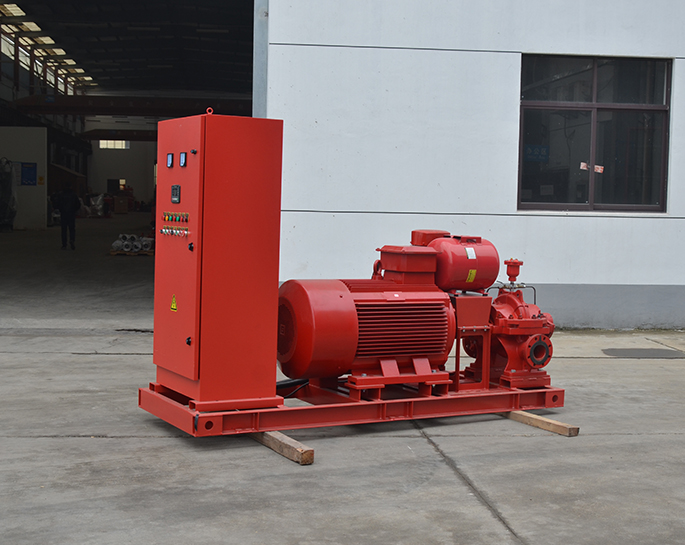How often should an electric fire pump be maintained?
May 27, 2024
Share:
Maintaining an electric fire pump involves a combination of regular inspections, testing, and preventive maintenance. The frequency of these activities is guided by standards such as NFPA 25 (Standard for the Inspection, Testing, and Maintenance of Water-Based Fire Protection Systems) and manufacturer recommendations. Here’s a detailed breakdown of the maintenance schedule for an electric fire pump:
1. **Weekly Maintenance:**
- **Inspection:** Visual inspection of the pump, controller, and other components.
- **Running Test:** Operate the pump without water flow (churn test) for a minimum of 10 minutes to ensure proper operation. Check for unusual noises, vibrations, or leaks.
- **Controller Inspection:** Check the controller for any error codes or alarms and ensure it is in the automatic position.
2. **Monthly Maintenance:**
- **Full-Flow Test:** Run the pump under full-flow conditions to verify performance. This involves flowing water through the system and measuring pressure and flow rates to ensure they meet design specifications.
- **Battery Inspection:** For battery-powered components, inspect the batteries for corrosion and ensure they are fully charged.
3. **Quarterly Maintenance:**
- **Valve Inspection:** Inspect all system valves to ensure they are in the correct position and operate properly.
- **Electrical Connections:** Check all electrical connections for tightness and signs of wear or corrosion.
4. **Annual Maintenance:**
- **Comprehensive Inspection:** Conduct a thorough inspection of the entire pump system, including mechanical components, electrical systems, and control panels.
- **Performance Test:** Perform a comprehensive performance test, including a full-flow test and a no-flow (churn) test, to verify the pump meets all performance criteria.
- **Alignment and Couplings:** Inspect and adjust the alignment of the pump and motor shafts, and check all couplings for wear.
- **Lubrication:** Lubricate all moving parts according to the manufacturer's recommendations.
5. **Five-Year Maintenance:**
- **Internal Inspection:** Conduct an internal inspection of the pump casing, impeller, and other internal components to check for wear, corrosion, or damage.
- **Performance Curve Verification:** Reverify the pump's performance curve to ensure it still meets the original specifications.
6. **As-Needed Maintenance:**
- **Repairs:** Perform necessary repairs promptly when issues are identified during inspections or tests.
- **Component Replacement:** Replace worn or damaged components as recommended by the manufacturer or based on the results of inspections and tests.
**Documentation and Record Keeping:**
- Maintain detailed records of all inspections, tests, maintenance activities, and repairs. This documentation should include dates, findings, actions taken, and personnel involved.
- Ensure that maintenance logs are easily accessible for review by authorities having jurisdiction (AHJs) and for internal audits.
By adhering to this maintenance schedule, you can ensure your electric fire pump remains in optimal working condition, ready to perform effectively in case of a fire emergency.

1. **Weekly Maintenance:**
- **Inspection:** Visual inspection of the pump, controller, and other components.
- **Running Test:** Operate the pump without water flow (churn test) for a minimum of 10 minutes to ensure proper operation. Check for unusual noises, vibrations, or leaks.
- **Controller Inspection:** Check the controller for any error codes or alarms and ensure it is in the automatic position.
2. **Monthly Maintenance:**
- **Full-Flow Test:** Run the pump under full-flow conditions to verify performance. This involves flowing water through the system and measuring pressure and flow rates to ensure they meet design specifications.
- **Battery Inspection:** For battery-powered components, inspect the batteries for corrosion and ensure they are fully charged.
3. **Quarterly Maintenance:**
- **Valve Inspection:** Inspect all system valves to ensure they are in the correct position and operate properly.
- **Electrical Connections:** Check all electrical connections for tightness and signs of wear or corrosion.
4. **Annual Maintenance:**
- **Comprehensive Inspection:** Conduct a thorough inspection of the entire pump system, including mechanical components, electrical systems, and control panels.
- **Performance Test:** Perform a comprehensive performance test, including a full-flow test and a no-flow (churn) test, to verify the pump meets all performance criteria.
- **Alignment and Couplings:** Inspect and adjust the alignment of the pump and motor shafts, and check all couplings for wear.
- **Lubrication:** Lubricate all moving parts according to the manufacturer's recommendations.
5. **Five-Year Maintenance:**
- **Internal Inspection:** Conduct an internal inspection of the pump casing, impeller, and other internal components to check for wear, corrosion, or damage.
- **Performance Curve Verification:** Reverify the pump's performance curve to ensure it still meets the original specifications.
6. **As-Needed Maintenance:**
- **Repairs:** Perform necessary repairs promptly when issues are identified during inspections or tests.
- **Component Replacement:** Replace worn or damaged components as recommended by the manufacturer or based on the results of inspections and tests.
**Documentation and Record Keeping:**
- Maintain detailed records of all inspections, tests, maintenance activities, and repairs. This documentation should include dates, findings, actions taken, and personnel involved.
- Ensure that maintenance logs are easily accessible for review by authorities having jurisdiction (AHJs) and for internal audits.
By adhering to this maintenance schedule, you can ensure your electric fire pump remains in optimal working condition, ready to perform effectively in case of a fire emergency.


.png)
.png)

.png)


